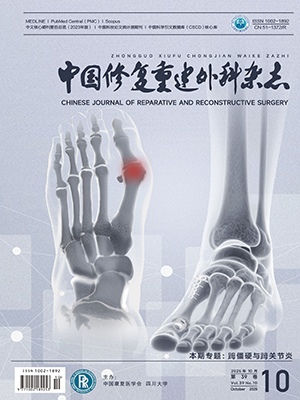| 1. |
Freedman JD, Eidelman M, Apt E, et al. Review of current concepts in metatarsus adductus. Pediatr Ann, 2024, 53(4): e152-e156.
|
| 2. |
Bohne W. Metatarsus adductus. Bull N Y Acad Med, 1987, 63(9): 835-838.
|
| 3. |
Ferrari J, Malone-Lee J. A radiographic study of the relationship between metatarsus adductus and hallux valgus. J Foot Ankle Surg, 2003, 42(1): 9-14.
|
| 4. |
Dawoodi AI, Perera A. Reliability of metatarsus adductus angle and correlation with hallux valgus. Foot Ankle Surg, 2012, 18(3): 180-186.
|
| 5. |
Coughlin MJ. Juvenile hallux valgus//Coughlin MJ, Mann RA. Surgery of the foot and ankle. 7th ed. St. Louis: Mosby, 1999: 270-319.
|
| 6. |
Sharma J, Aydogan U. algorithm for severe hallux valgus associated with metatarsus adductus. Foot Ankle Int, 2015, 36(12): 1499-503.
|
| 7. |
Mann RA, Coughlin MJ. Hallux valgus—etiology, anatomy, treatment and surgical considerations. Clin Orthop Relat Res, 1981, (157): 31-41.
|
| 8. |
Reimann I, Werner HH. Congenital metatarsus varus: A suggestion for a possible mechanism and relation to other foot deformities. Clin Orthop Relat Res, 1975(110): 223-226.
|
| 9. |
Aiyer AA, Shariff R, Ying L. Prevalence of metatarsus adductus in patients undergoing hallux valgus surgery. Foot Ankle Int, 2014, 35(12): 1292-1297.
|
| 10. |
Okuda R, Kinoshita M, Morikawa J. Adult hallux valgus with metatarsus adductus: a case report. Clin Orthop Relat Res, 2002, (396): 179-183.
|
| 11. |
Loh B, Chen JY, Yew AK. Prevalence of metatarsus adductus in symptomatic hallux valgus and its influence on functional outcome. Foot Ankle Int, 2015, 36(11): 1316-1321.
|
| 12. |
Martinelli N, Marinozzi A, Cancilleri F, et al. Hallux valgus correction in a patient with metatarsus adductus with multiple distal oblique osteotomies. J Am Podiatr Med Assoc, 2010, 100(3): 204-208.
|
| 13. |
Poggio D, de Retana PF, Borda D. Analysis of the clinical score progressions during the first year after first MTPJ fusion. Foot Ankle Int, 2010, 31(7): 578-583.
|
| 14. |
Wood EV, Walker CR, Hennessy MS. First metatarsophalangeal arthrodesis for hallux valgus. Foot Ankle Clin, 2014, 19(2): 245-258.
|
| 15. |
Pydah SK, Toh EM, Sirikonda SP, et al. Intermetatarsal angular change following fusion of the first metatarsophalangeal joint. Foot Ankle Int, 2009, 30(5): 415-418.
|
| 16. |
Feilmeier M, Dayton P, Wienke JC. Reduction of intermetatarsal angle after first metatarsophalangeal joint arthrodesis in patients with hallux valgus. J Foot Ankle Surg, 2014, 53(1): 29-31.
|
| 17. |
DeFrino PF, Brodsky JW, Pollo FE, et al. First metatarsophalangeal arthrodesis: a clinical, pedobarographic and gait analysis study. Foot Ankle Int, 2002, 23(6): 496-502.
|
| 18. |
van Doeselaar DJ, Heesterbeek PJ, Louwerens JW, et al. Foot function after fusion of the first metatarsophalangeal joint. Foot Ankle Int, 2010, 31(8): 670-675.
|




